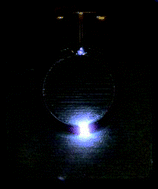 A microwave discharge using <1 W is demonstrated as a spectroscopic source for detection of sulfur, hydrocarbons, and oxygen.
A microwave discharge using <1 W is demonstrated as a spectroscopic source for detection of sulfur, hydrocarbons, and oxygen.
Atmospheric pressure microplasmas are a promising technology for low-power optical emission spectroscopy for chemical detection. In this work, Alan Hoskinson and co-workers from Massachusetts, USA examine a microstrip split-ring resonator (MSRR) discharge operating at 1.8 GHz in helium as an excitation source. The source can sustain a plasma with as little as 0.2 W of microwave power, and can be operated continuously with no electrode damage.
Based on the stability, low power consumption and detection limits, which compare favourably to other low and moderate power plasma excitation sources, the MSRR plasma is a promising technology for use in portable systems.
Interested in knowing more? Read for free until 4th April.
Low-power microwave-generated helium microplasma for molecular and atomic spectrometry
Alan R. Hoskinson, Jeffrey Hopwood, Neil W. Bostrom, Jeffrey A. Crank and Christopher Harrison
J. Anal. At. Spectrom., 2011, Advance Article
DOI: 10.1039/C0JA00239A










